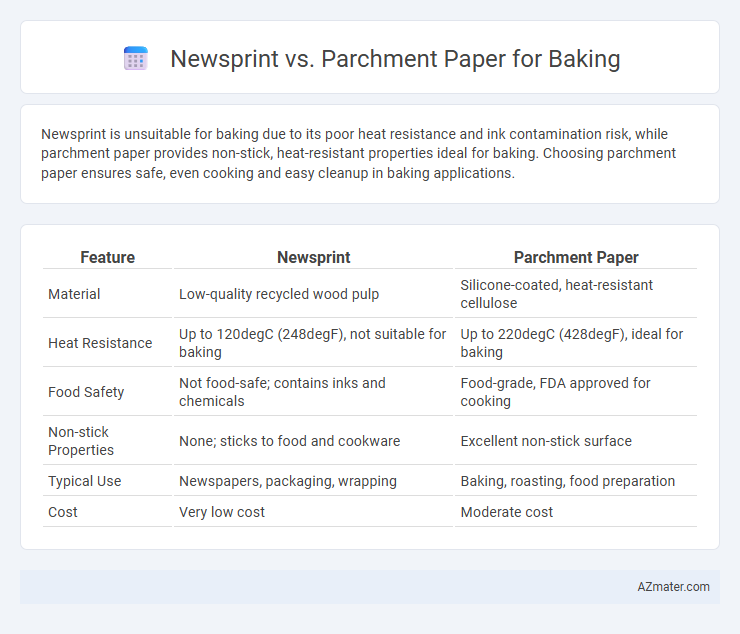Newsprint is unsuitable for baking due to its poor heat resistance and ink contamination risk, while parchment paper provides non-stick, heat-resistant properties ideal for baking. Choosing parchment paper ensures safe, even cooking and easy cleanup in baking applications.
Table of Comparison
| Feature | Newsprint | Parchment Paper |
|---|---|---|
| Material | Low-quality recycled wood pulp | Silicone-coated, heat-resistant cellulose |
| Heat Resistance | Up to 120degC (248degF), not suitable for baking | Up to 220degC (428degF), ideal for baking |
| Food Safety | Not food-safe; contains inks and chemicals | Food-grade, FDA approved for cooking |
| Non-stick Properties | None; sticks to food and cookware | Excellent non-stick surface |
| Typical Use | Newspapers, packaging, wrapping | Baking, roasting, food preparation |
| Cost | Very low cost | Moderate cost |
Introduction: Choosing the Right Paper for Baking
Selecting the ideal paper for baking significantly influences the outcome and safety of your recipes. Newsprint is unsuitable due to its ink and chemical content, which can leach harmful substances when heated. Parchment paper offers a non-stick, heat-resistant surface that withstands high temperatures without compromising food quality or safety.
What is Newsprint?
Newsprint is a low-cost, non-bleached paper primarily used for printing newspapers, characterized by its rough texture and high absorbency. Unlike parchment paper, which is designed to be heat-resistant and non-stick for baking purposes, newsprint can release ink and may ignite or burn easily under high oven temperatures. Due to its composition and printing ink, newsprint is not recommended for direct food contact or baking applications.
What is Parchment Paper?
Parchment paper is a cellulose-based, non-stick baking material coated with silicone, designed to withstand high oven temperatures up to 420degF (215degC) without burning or sticking. Unlike newsprint, which is not food-safe and can release harmful inks and chemicals when heated, parchment paper provides a safe, grease-resistant surface ideal for baking cookies, roasting vegetables, and lining cake pans. Its heat resistance and non-reactive nature make parchment paper essential for consistent, mess-free baking and easy cleanup.
Composition and Safety Standards
Newsprint is made from recycled wood pulp containing inks and chemicals that can release toxins when exposed to heat, making it unsafe for baking purposes. Parchment paper is crafted from cellulose fibers treated with non-stick silicone coatings and meets FDA food safety standards, ensuring it withstands high baking temperatures without chemical leaching. Choosing parchment paper guarantees compliance with food-grade safety regulations and prevents contamination during cooking.
Heat Resistance and Oven Suitability
Newsprint is not suitable for baking as it lacks heat resistance and can easily ignite or release harmful chemicals in the oven. Parchment paper is specifically designed for cooking and baking, offering excellent heat resistance up to approximately 420degF (215degC) without burning or sticking. Its non-stick surface and oven safety make parchment paper the preferred choice for lining baking trays and preventing food from sticking during high-temperature cooking.
Nonstick Performance Comparison
Parchment paper exhibits superior nonstick performance compared to newsprint, preventing baked goods from adhering to surfaces and ensuring easy release. Newsprint lacks the heat-resistant, silicone-coated qualities of parchment paper, resulting in increased sticking and potential ink transfer during baking. Using parchment paper enhances baking efficiency and food presentation due to its reliable nonstick properties.
Impact on Food Flavor and Texture
Newsprint is unsuitable for baking as its ink contains toxic chemicals that can leach into food, negatively impacting flavor and posing health risks. Parchment paper, made from cellulose treated with silicone, provides a non-stick, heat-resistant surface that preserves food texture and flavor without contamination. Using parchment paper ensures baked goods maintain optimal moisture, crispness, and taste integrity.
Environmental Considerations
Newsprint contains inks and dyes that can release harmful chemicals when exposed to heat, making it unsuitable and unsafe for baking purposes. Parchment paper is specifically designed for baking, being non-toxic, biodegradable, and often compostable, which makes it a more environmentally friendly choice. Using parchment paper helps reduce chemical contamination and supports sustainable kitchen practices compared to repurposing newsprint.
Cost and Accessibility
Newsprint is significantly cheaper than parchment paper, making it an attractive option for those on a tight budget; however, it is not designed for baking and can release harmful inks or chemicals when exposed to heat. Parchment paper, although more expensive, offers reliable non-stick and heat-resistant properties, widely available in grocery and specialty stores. The accessibility of parchment paper in various sizes and pre-cut sheets provides convenience that newsprint cannot match, justifying its higher cost for safe baking applications.
Verdict: Which Paper is Best for Baking?
Parchment paper is the superior choice for baking due to its non-stick, heat-resistant, and moisture-resistant properties, ensuring consistent results and easy cleanup. Newsprint paper lacks heat resistance and can release harmful inks or chemicals when exposed to high temperatures, making it unsafe and unsuitable for baking purposes. Bakers should always opt for food-grade parchment paper to maintain food safety and optimize baking performance.

Infographic: Newsprint vs Parchment Paper for Baking
 azmater.com
azmater.com